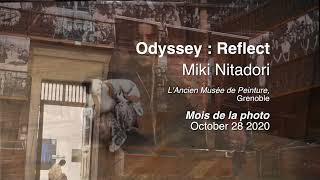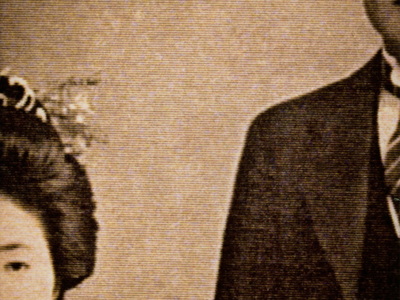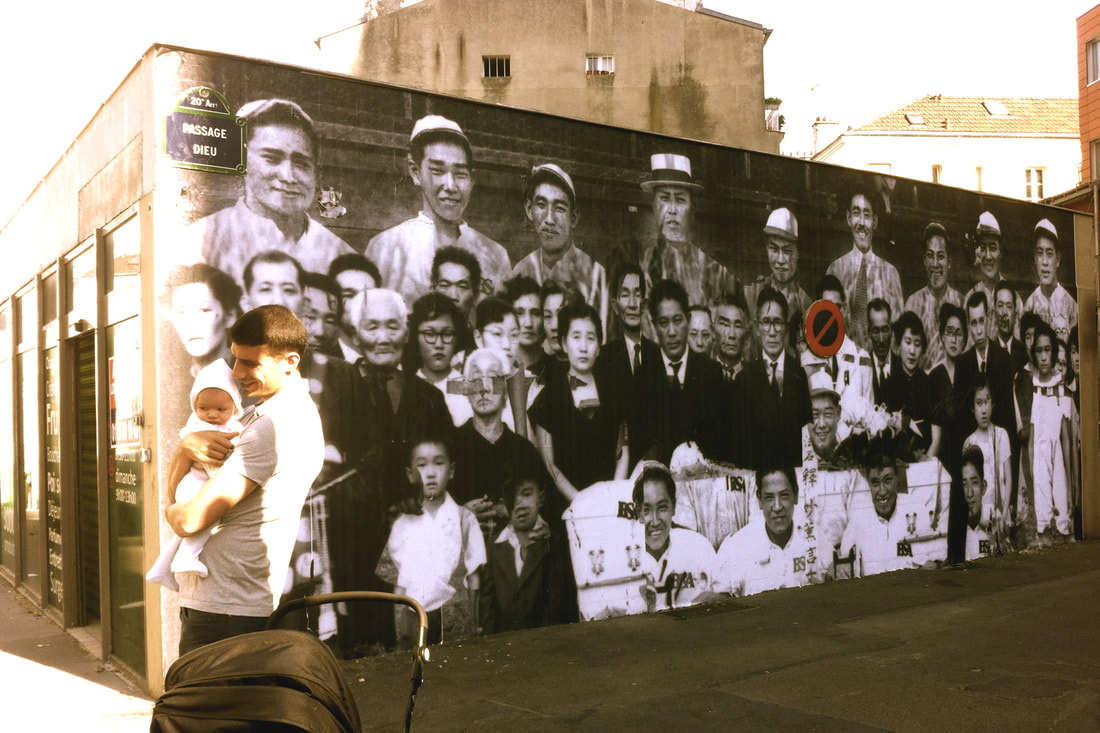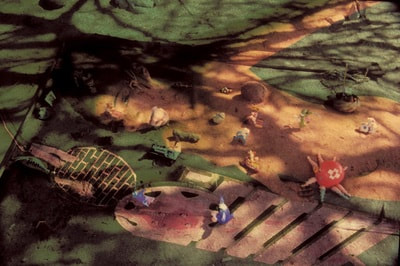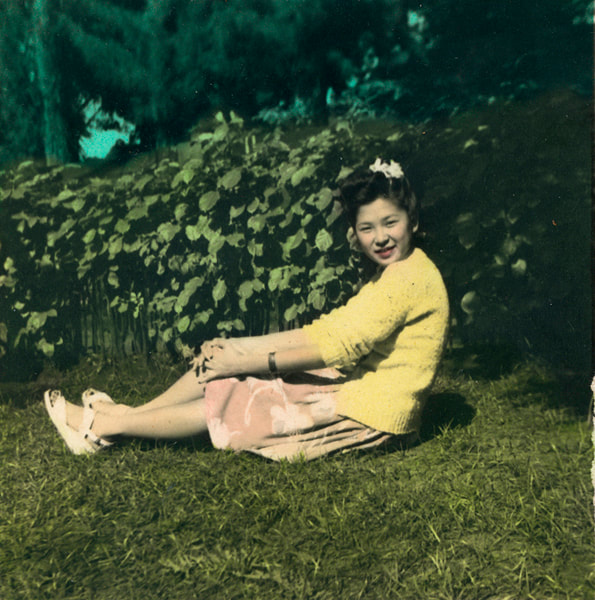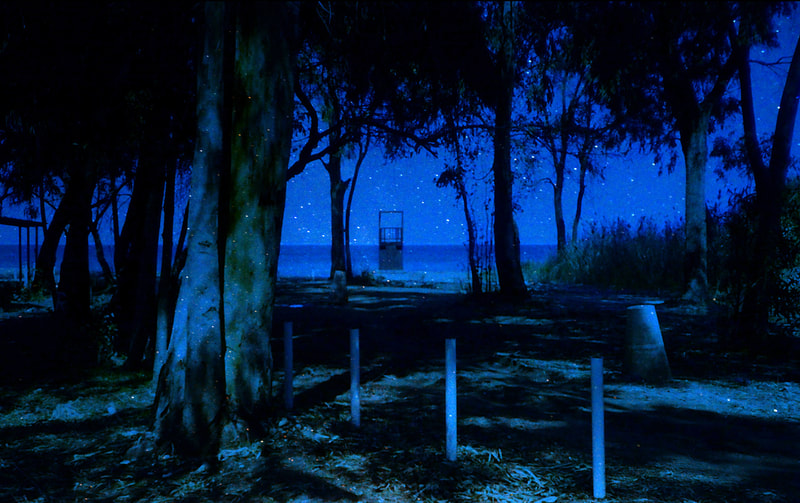Odyssey : Reflect, Archive photographs, Transferred Manually on to printed textiles, Unique piece, 27 x 35 cm, 35 x 120 cm, 81x 92 cm, 81 x 160 cm, 81 x 190 cm, 2013-2015
Odyssey : reflect 2013-2015
Odyssey : reflect, my most recent work, was born from a suitcase filled with photographs which a Japanese-American family had left in Lahaina, Maui, Hawai’i, where I grew up.
I did not know the man who found the suitcase, a Frenchman called Thomas Hardy. One day, by pure chance, he visited my studio in Paris, saw a photograph of Lahaina sugarcane mill on the wall and mentioned to me about the photographs he brought back. He showed me the pictures, only once. Then we met —once again by chance— in a travel agency two years later. He was leaving France for good and decided to give the suitcase to me. For years I kept the photographs almost untouched, looking at them and using parts of them in some of my works. However, I didn’t really know what to do with them.
Maui was my longest-lasting home when I was growing up. It was the place I rooted within myself thanks to the help from my friends - the first, second, third, forth and fifth generations of Japanese-Americans.
Suddenly in 2013, when I was invited for an exhibition by the Maui Arts and Cultural Center and the Honolulu Museum of Art, I realized what was happening: the photographs needed to go home, and they were using me. I was a go-between in their odyssey, from the old generations to the youth of today. The message seemed to be: Don’t forget your ancestors. Don’t forget the place you come from.
I want to shed a new light on supposedly ordinary photographs, dating from the end of the 19th century to the 1950s. Each home has these kinds of portraits, sleeping in a dark corner of the house.
Odyssey follows a precise protocol. Having scanned and enlarged the pictures, I transfer them manually onto printed fabrics. These embody for me the plurality of cultural, traditional and symbolic patterns - patterns also echoing between the people in the photographs and the viewer. Odyssey is my reconstruction of anonymous histories based on my own life experience, questions and research.
Hawai’i 's first known contact with the West was Captain Cook in the late 18th century. A century later the Portuguese and Asian immigrants settled. Japanese immigrants re-interpreted European cloths (Gingham, Vichy - called Palka in Hawai’I) were used as working clothes. Later they used kimono fabric for the Aloha shirts sold in Hawai’i.
For me the shapes, patterns, images and words used these fabrics are not merely ornamental. I was born and raised in cultures haunted by signs and shapes. In superimposing photographs and fabrics (pattern, drawing, design) I seek to question the invisible realities of immigration.
The exhibition was shown at the Honolulu museum of art .
http://honolulumuseum.org/art/exhibitions/13988-first_h/
Month of photography at paris
http://www.mep-fr.org/evenement/miki-nitadori/
I did not know the man who found the suitcase, a Frenchman called Thomas Hardy. One day, by pure chance, he visited my studio in Paris, saw a photograph of Lahaina sugarcane mill on the wall and mentioned to me about the photographs he brought back. He showed me the pictures, only once. Then we met —once again by chance— in a travel agency two years later. He was leaving France for good and decided to give the suitcase to me. For years I kept the photographs almost untouched, looking at them and using parts of them in some of my works. However, I didn’t really know what to do with them.
Maui was my longest-lasting home when I was growing up. It was the place I rooted within myself thanks to the help from my friends - the first, second, third, forth and fifth generations of Japanese-Americans.
Suddenly in 2013, when I was invited for an exhibition by the Maui Arts and Cultural Center and the Honolulu Museum of Art, I realized what was happening: the photographs needed to go home, and they were using me. I was a go-between in their odyssey, from the old generations to the youth of today. The message seemed to be: Don’t forget your ancestors. Don’t forget the place you come from.
I want to shed a new light on supposedly ordinary photographs, dating from the end of the 19th century to the 1950s. Each home has these kinds of portraits, sleeping in a dark corner of the house.
Odyssey follows a precise protocol. Having scanned and enlarged the pictures, I transfer them manually onto printed fabrics. These embody for me the plurality of cultural, traditional and symbolic patterns - patterns also echoing between the people in the photographs and the viewer. Odyssey is my reconstruction of anonymous histories based on my own life experience, questions and research.
Hawai’i 's first known contact with the West was Captain Cook in the late 18th century. A century later the Portuguese and Asian immigrants settled. Japanese immigrants re-interpreted European cloths (Gingham, Vichy - called Palka in Hawai’I) were used as working clothes. Later they used kimono fabric for the Aloha shirts sold in Hawai’i.
For me the shapes, patterns, images and words used these fabrics are not merely ornamental. I was born and raised in cultures haunted by signs and shapes. In superimposing photographs and fabrics (pattern, drawing, design) I seek to question the invisible realities of immigration.
The exhibition was shown at the Honolulu museum of art .
http://honolulumuseum.org/art/exhibitions/13988-first_h/
Month of photography at paris
http://www.mep-fr.org/evenement/miki-nitadori/
You may be interested in




